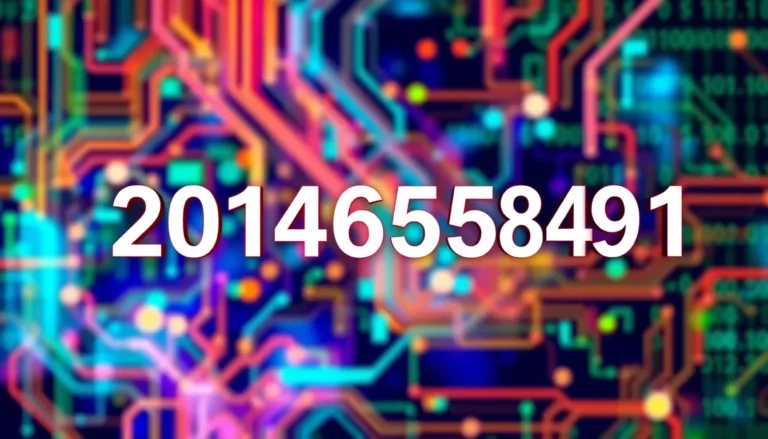In a world where toasters can tweet and fridges can remind you to buy milk, the Internet of Things (IoT) isn’t just a buzzword—it’s a revolution. Understanding IoT keywords is like having the secret recipe for the ultimate tech smoothie. It’s essential for anyone looking to navigate this connected universe and stay ahead of the curve.
Table of Contents
ToggleImportance of Internet of Things Keywords
Understanding Internet of Things keywords plays a crucial role in grasping the full scope of IoT technology. Keywords help individuals and businesses identify relevant trends, enabling them to stay current with advancements. Recognizing these terms simplifies communication about IoT devices and their functionalities.
Awareness of IoT terminology enhances search engine optimization strategies. Effective use of specific keywords drives traffic to websites, boosting visibility in a competitive market. Targeted keywords facilitate content creation, ensuring it meets user intent and addresses specific needs.
Inclusion of recognized IoT keywords can improve user experience. Clarity in language helps users quickly locate information, increasing engagement with content. Familiar keywords establish credibility, allowing businesses to connect with their audience more easily.
Organizing content around Internet of Things keywords contributes to overall knowledge sharing. Educational materials that incorporate these terms enhance readers’ understanding of IoT applications. Knowledgeable discussions regarding industry trends arise when experts use established vocabulary.
Relevance extends beyond individual users. Businesses that adopt proper keywords find opportunities for collaboration and partnerships. Engaging stakeholders through shared terminology fosters innovation and development within IoT sectors.
Utilization of IoT keywords in marketing strategies influences audience targeting. Effective campaigns attract potential customers by resonating with their interests and needs. Keywords often reflect the latest technological trends, informing marketing decisions and product development.
Common Internet of Things Keywords

Familiarity with specific IoT keywords enhances understanding of this expanding technological domain. These keywords cover various aspects, ranging from technical jargon to industry-specific terms, which aid users in navigating this landscape.
Technical Terms
Terms like “sensors” play a pivotal role in IoT. Sensors collect data from the environment, allowing devices to respond intelligently. “Connectivity” refers to how IoT devices communicate over networks, including both wired and wireless options. “Cloud computing” signifies the storage and processing of data on remote servers, facilitating easy access and management. Data analytics involves processing collected information to derive actionable insights, helping organizations make informed decisions. “Edge computing” allows data to be processed closer to the source, reducing latency. Each term holds significant importance in understanding IoT’s technical framework.
Industry-Specific Terms
Sector-specific keywords include “smart home,” which describes interconnected household devices that improve convenience and efficiency. “Wearables” refer to smart technology worn by individuals, often for health monitoring or fitness tracking. In the healthcare sector, “remote patient monitoring” ensures health data is collected in real time, supporting proactive medical care. “Smart cities” represent urban areas that integrate IoT technologies for improved infrastructure and services. “Industrial IoT” covers IoT applications in manufacturing and supply chain management, enhancing operational efficiency. Each of these terms plays a crucial role in delineating the diverse applications of IoT across various industries.
Long-Tail Keywords in the Internet of Things
Long-tail keywords play a vital role in optimizing content within the Internet of Things (IoT) landscape. These specific phrases enhance targeting and improve search visibility.
Benefits of Long-Tail Keywords
Long-tail keywords drive focused traffic by attracting users seeking specific information. They often result in higher conversion rates, as visitors searching these phrases typically have a clear intent. Less competition exists for long-tail keywords compared to broader terms, making it easier for businesses to rank higher in search engines. Additional advantages include fostering a better understanding of user needs, helping brands tailor their content effectively. Implementing these keywords increases overall relevance, ultimately boosting audience engagement.
Examples of Long-Tail Keywords
Examples of long-tail keywords include “best smart home security systems,” “IoT solutions for healthcare,” and “applications of edge computing in manufacturing.” These detailed phrases cater to specific inquiries, enhancing visibility. “How to connect smart appliances to Wi-Fi” and “benefits of industrial IoT for manufacturers” represent particular interests within the IoT space. Additionally, “impact of IoT on city infrastructure” and “wearable technology for fitness tracking” serve to differentiate content targeted to niche markets. Each example illustrates a focused approach to capturing interested audiences.
How to Use Internet of Things Keywords Effectively
Using Internet of Things keywords effectively enhances content visibility and engagement. Targeting specific terms related to IoT helps attract the right audience. Start by incorporating commonly searched terms into headings and subheadings, which aids in SEO.
Long-tail keywords play a crucial role. Phrases like “best smart home security systems” address specific user inquiries, enhancing relevance and searchability. Individuals or businesses can use tools like Google Keyword Planner or SEMrush to identify trending IoT phrases. Monitoring competitors’ keywords also provides insights into effective strategies.
Creating valuable content around chosen keywords is essential. Users engage more when content addresses their questions. Integrating keywords naturally into the text often results in better readability and user experience.
Including keywords in image alt tags and meta descriptions also boosts SEO. Descriptive image captions ensure that search engines understand content context effectively.
Further, sharing content on social media platforms amplifies keyword reach. Engaging with followers creates opportunities for additional keyword variations based on user interactions.
Analyzing content performance is key to ongoing improvement. Tracking metrics shows how specific keywords perform over time. Adjusting strategies based on data allows for optimized content that resonates with the target audience.
Using IoT keywords effectively requires a strategic approach. Focusing on high-value keywords, long-tail phrases, and comprehensive analysis fosters improved online visibility and communication. Engaged audiences lead to collaboration and innovation in the ever-evolving IoT landscape.
Mastering IoT keywords is crucial for anyone looking to thrive in today’s digital landscape. By understanding and utilizing these terms effectively, individuals and businesses can enhance their online presence and engage their target audience more efficiently.
A strategic approach to incorporating both technical and industry-specific keywords not only improves search engine visibility but also fosters clearer communication. This ultimately leads to better user experiences and increased collaboration within the IoT ecosystem.
As the Internet of Things continues to evolve, staying updated with relevant terminology will empower users to navigate this intricate technological world with confidence.



